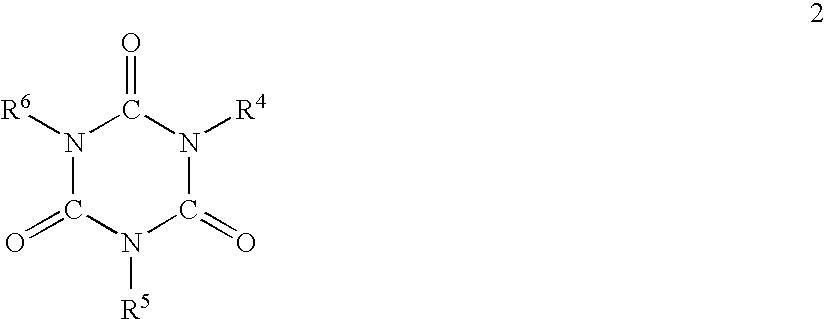Extruded styrene resin foam and process for producing the same
a technology of styrene resin and extrusion process, which is applied in the direction of fireproof paints, etc., can solve the problems of insufficient foaming energy, difficult to obtain satisfactory foams, and difficult to achieve foams with low density, etc., to achieve excellent environmental compatibility and excellent thermal insulation properties
- Summary
- Abstract
- Description
- Claims
- Application Information
AI Technical Summary
Benefits of technology
Problems solved by technology
Method used
Image
Examples
example a1
A polystyrene resin available under the trade name “Styron G9401” made by A&M Styrene Co., Ltd. was used. To 100 parts of the polystyrene resin were dry-blended 3.5 parts of hexabromocyclododecane (hereinafter abbreviated to HBCD) as a halogenated flame retardant, 3 parts of isocyanuric acid (made by Shikoku Corporation, trade name: ICA-P) as a nitrogen-containing compound, 1 part of triphenyl phosphate (made by Ajinomoto Co., Inc., TPP) as a phosphoric acid ester compound, 1 part of bentonite (made by Hojun Kogyo Co., Ltd., trade name: BENGEL 23), 0.1 part of dehydrated silica (made by Nippon Aerosil Co., Ltd., trade name: AEROSIL) as an inorganic powder having a large number of hydroxyl groups, 0.1 part of talc as a nucleating agent, and 0.25 part of barium stearate as a lubricating agent, and then the resultant resin mixture was supplied to a tandem type extruder. The resin mixture supplied to a first extruder was heated to about 200° C. and melted or plasticized and kneaded, and...
example a2
A polystyrene resin available under the trade name “Styron G9401” made by A&M Styrene Co., Ltd. was used. To 100 parts of the polystyrene resin were dry-blended 3 parts of HBCD, 3 parts of isocyanuric acid, 1 part of triphenyl phosphate, 1 part of bentonite, 0.1 part of dehydrated silica, 0.1 part of talc, and 0.25 part of barium stearate, and then the resultant resin mixture was supplied to a tandem type extruder. The resin mixture supplied to a first extruder was heated to about 200° C. and melted or plasticized and kneaded, and then the resultant was cooled to about 110° C. to about 130° C. in a second extruder connected to the first extruder and further a cooling device and extruded to the atmosphere through a die attached to the tip of the cooling device. The extruded foam was shaped by means of a forming mold and forming rolls to obtain an extruded foam board having a cross-section with about 60 mm thickness and about 1,000 mm width.
In this case, as blowing agents, 4 parts of ...
example a3
A polystyrene resin available under the trade name “Styron G9401” made by A&M Styrene Co., Ltd. was used. To 100 parts of the polystyrene resin were dry-blended 3.5 parts of HBCD, 3 parts of isocyanuric acid, 0.5 part of triphenyl phosphate, 1.5 parts of bentonite, 0.1 part of dehydrated silica, 0.1 part of talc, and 0.25 part of barium stearate, and then the resultant resin mixture was supplied to a tandem type extruder. The resin mixture supplied to a first extruder was heated to about 200° C. and melted or plasticized and kneaded, and then the resultant was cooled to about 110° C. to about 130° C. in a second extruder connected to the first extruder and further a cooling device and extruded to the atmosphere through a die attached to the tip of the cooling device. The extruded foam was shaped by means of a forming mold and forming rolls to obtain an extruded foam board having a cross-section with about 60 mm thickness and about 1,000 mm width.
In this case, as blowing agents, 3.5 ...
PUM
| Property | Measurement | Unit |
|---|---|---|
| cell size | aaaaa | aaaaa |
| cell size | aaaaa | aaaaa |
| density | aaaaa | aaaaa |
Abstract
Description
Claims
Application Information
 Login to View More
Login to View More - R&D
- Intellectual Property
- Life Sciences
- Materials
- Tech Scout
- Unparalleled Data Quality
- Higher Quality Content
- 60% Fewer Hallucinations
Browse by: Latest US Patents, China's latest patents, Technical Efficacy Thesaurus, Application Domain, Technology Topic, Popular Technical Reports.
© 2025 PatSnap. All rights reserved.Legal|Privacy policy|Modern Slavery Act Transparency Statement|Sitemap|About US| Contact US: help@patsnap.com



